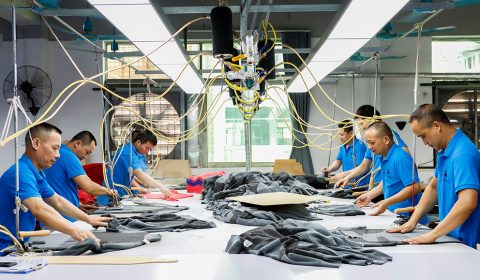Wool and cashmere are both popular natural fibers that play a unique role in the textile industry. Wool is derived from sheep, while cashmere comes mainly from goats in plateau and mountain regions. There are significant differences in the characteristics, origin and use of the two fibers. In the following articles, we will delve into the nuances between the two to better understand their different applications in textile manufacturing.
Wool is a widely used natural fiber, and its main source is the hair of sheep. Such fibers typically have a large diameter, a relatively short length, and a relatively rough fiber structure. The production of wool is huge because sheep are widely distributed all over the world. In textile manufacturing, wool is known for its excellent thermal properties and is widely used in the production of winter clothing, blankets and carpets. Its fiber length is suitable for making strong and durable textiles, but because of its relatively short length, it is suitable for some fine textiles.
Cashmere, by contrast, is a relatively scarce fiber that comes mainly from goats in alpine regions, such as Tibetan antelope and Kailuan sheep. The fibers of cashmere are relatively fine and soft and have a long length, usually 4-6 inches or more. This makes cashmere an ideal choice for making high-end cashmere sweaters, scarves and other fashion items. Due to the softness and fineness of its fibers, cashmere is able to maintain the lightness and comfort of the textile while providing excellent warmth retention.
Source
Wool, as a natural fiber, comes mainly from the hair of sheep. These sheep are widely distributed globally and are adapted to a variety of climatic and environmental conditions. Wool produced by different breeds of sheep varies in fiber characteristics, including fiber thickness, length, etc. Wool growth is a cyclical process, usually once a year. During this cycle, the sheep’s hair will gradually grow and reach maturity at a specific time. The yield and quality of wool is affected by many factors, including the breed of sheep, breeding conditions, and seasons.
Wool is usually collected by shearing to ensure maximum protection of fiber integrity. Once collected, the wool can undergo subsequent processing, including washing, carding and spinning, so that it can be used to make a variety of textiles, such as sweaters, blankets and carpets.
Cashmere mainly comes from goats living in mountainous and plateau areas, which are adapted to the harsher environmental conditions. Some famous sources of cashmere include Tibetan antelope and Kailuan sheep. The climatic conditions of these mountain areas, such as low temperatures and high altitudes, provide a good natural environment for the formation of cashmere.
Cashmere is relatively difficult to obtain because it usually needs to be done during the season when the animals are shedding their hair, which is a short period and is done in high cold regions. Gathering cashmere requires careful handling to ensure that the goats are not harmed and that the quality of the wool is maintained. Similar to wool, the subsequent treatment of cashmere involves cleaning, carding and spinning to make high-grade cashmere textiles.
Fiber characteristics
Wool fibers are known for their relatively rough properties. This roughness is mainly due to the large diameter of the fiber of sheep wool. This allows wool fibers to exhibit strong wear resistance and durability in textiles. This makes wool an ideal choice for durable goods such as winter clothing, blankets and carpets. Its larger diameter fibers also help to create a sense of fluff on the textile, giving the garment more texture.
In addition, the wool fiber also has good elasticity, can maintain the shape of the clothing, not easy to produce wrinkles. This makes wool products easier to keep clean after wearing, reducing the need for routine maintenance.
In contrast, the fibers of cashmere are softer and generally softer than wool. This softness is mainly due to the smaller diameter and smoother surface of the cashmere fiber. This makes cashmere one of the preferred raw materials for high-grade textiles.
Due to its softness, cashmere clothing provides an extremely high level of comfort when worn. Its light and warm properties make cashmere clothing a fashion icon for the cold season. The fiber softness of cashmere also helps to create a luxurious touch, bringing a unique sense of quality to the designs of high-end fashion brands.
Fiber length
The fiber length of wool is an important feature in the spinning and weaving process. Typically, wool has a relatively short fiber length, typically between 2.5 and 4 inches. This short fiber length makes wool easier to handle and suitable for making many different types of textiles.
The short fiber length of wool means that when spinning, the fiber needs more twisting to form yarn. This situation results in a more delicate appearance of the wool yarn, while also increasing the sense of hair on its surface. This makes the fabric made of wool softer to the touch and has a unique feel.
Although the wool fiber is relatively short, it is this characteristic that makes wool ideal for making warm winter clothing, blankets and other chunky textiles. The structure of the short fiber also helps to form a strong textile when woven, enhancing the durability of the wool fabric.
Compared to wool, cashmere has a relatively long fiber length, usually 4-6 inches or more. This long fiber is one of the manifestations of the unique qualities of cashmere, providing it with a range of unique properties.
The long fibers make the spinning process of the cashmere yarn much easier. Longer fibers require less twisting in the spinning process, resulting in a smoother, finer, and more uniform yarn. This gives the cashmere fabric an outstanding shine and silky texture.
In addition, the long fibers also increase the strength and durability of the cashmere fabric. This allows cashmere products, such as high-end cashmere sweaters and scarves, to maintain a good look and stand the test of time.
Production and scarcity
The large production of wool is mainly due to the wide distribution of sheep and their rapid reproduction. Sheep are domestic animals found all over the world, are highly adaptable and live in different climates. This makes the production of wool relatively easy and able to meet a wide range of market needs. The breeding speed of sheep is also a reason for its large yield, making the wool quantity relatively abundant. Therefore, wool as a major fiber raw material, the supply is relatively sufficient, the price is relatively close to the people.
Cashmere, on the other hand, is relatively scarce, mainly because its acquisition requires it to be collected in the mountains of the alpine region. Goats that produce high-quality cashmere, such as Tibetan antelopes and Kailuan sheep, live in extreme environmental conditions, such as high altitudes and cold climates. This makes the collection process quite difficult and requires a lot of manpower and material resources. Due to these special natural conditions, the production of cashmere is limited, and it is more scarce than wool. This also provides a certain support for the price of cashmere, making it a high-grade, precious fiber raw material.
Temperature adjustment ability
Wool is known for its excellent thermal properties, thanks to its special fiber structure. Wool fibers exhibit tiny scale-like structures that can form layers of air between the fibers, providing effective insulation. This structure allows wool fibers to effectively capture and retain body heat, preventing the intrusion of cold outside air. Therefore, clothing made of wool becomes an ideal choice in cold weather, providing warmth and comfort to the wearer.
In addition to its thermal properties, wool also has the ability to absorb moisture and regulate humidity. It can absorb the moisture in the air, keep the body temperature within the appropriate range, and avoid the discomfort caused by too much moisture. This makes wool ideal for insulation in winter or cold climates.
Cashmere is also highly regarded for its unique temperature-regulating properties. In contrast, the fibers of cashmere are softer, making the clothing softer and more skin-friendly. This softness not only increases the comfort of wearing, but also plays a positive role in thermal performance.
Compared to wool, the fiber structure of cashmere is smoother and different from the scaly structure of wool. This makes cashmere clothing more breathable and better able to regulate body temperature. During the warm season, cashmere fibers can help dissipate excess heat and keep the wearer comfortable. This makes cashmere an ideal material for the spring and autumn seasons, providing warmth without being too hot.
Price and market demand
Due to the scarcity and noble quality of cashmere, its price is usually higher.
The high price of cashmere is mainly due to its unique origin and quality. First, cashmere usually comes from goats in the cold regions, such as the Kailuan sheep in Mongolia and the Tibetan antelope in Tibet. The climate conditions in these areas are harsh, and goats live in extremely cold environments, which results in softer and warmer fur. Because the collection of cashmere needs to be carried out under harsh natural conditions, as well as the complexity of the production process, this makes the production of cashmere relatively small, and therefore expensive.
Second, the fiber diameter of cashmere is usually finer than that of ordinary wool, which gives cashmere outstanding softness and comfort. This fiber characteristic determines the high-grade quality of cashmere textiles, so it is more sought after in the market. Consumers’ pursuit of high-quality, natural fibers has made cashmere products a high-profile presence in the luxury market.
As a widely used natural fiber, the price of wool in the market is relatively close to the people, mainly due to its large output and diversified uses. First, sheep breed relatively quickly and are widely distributed, resulting in a large supply of wool. This led to the widespread use of wool in the textile industry, meeting the public’s demand for affordable, durable and warm clothing.
Secondly, the wide range of uses of wool also plays a stabilizing role in its price. Wool is not only used to make clothes, but also widely used in carpets, blankets and other textiles. This variety of uses allows wool to adapt to the needs of different market levels, thus maintaining a relatively affordable price level.




 English
English Deutsch
Deutsch Français
Français Italiano
Italiano Español
Español Русский
Русский Polski
Polski Nederlands
Nederlands Svenska
Svenska

